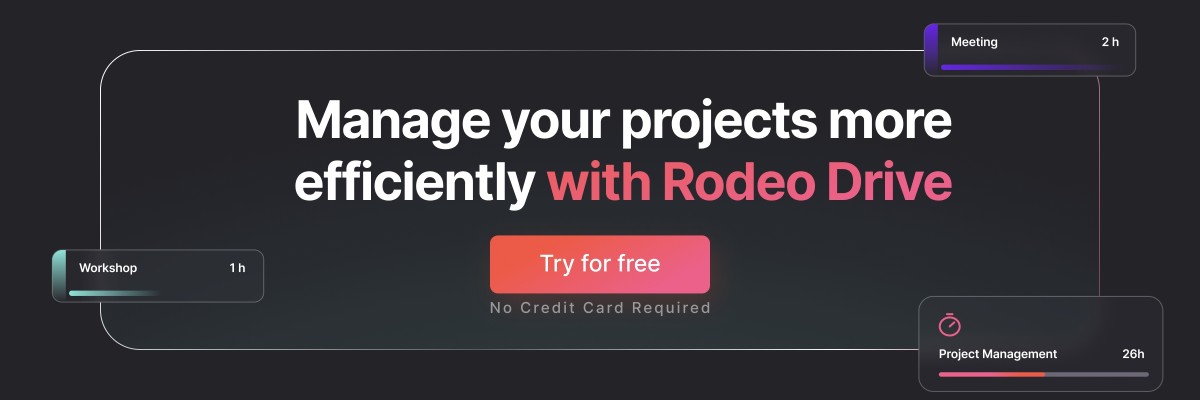Work From Home Best Practices: Your Guide to Successful Remote Work
There is no doubt that working from home is a phenomenon gaining speed and popularity.
Millions of people have found comfort and convenience when it comes to working remotely, and a full return to the office is not only not desirable, but a deal breaker for many looking for a new role.
The PwC US Remote Work Survey showed that 52% of employers agreed that employee productivity has increased since working remotely. And with online platforms such as Zoom, Slack, and Rodeo Drive which help connect teams and manage collaboration, teams can work remotely (or hybrid) with ease.
Whether you’re working hybrid or getting used to working entirely from home, adapting to a new environment can be difficult. If you’re looking for working from home best practices and tips, follow along here.

Challenges of working from home
Working from home is not for everyone, as it requires an incredible amount of self-discipline.
For example, work can infringe on your personal life and make you feel that you’re always on call. Additionally, some might feel isolated while working one hundred percent remotely, which also influences team bonding and company culture.
Although many people love working from home, let’s take a look at three main challenges remote employees face.
#1 Lack of work-life balance
Working and living in the same space can be detrimental to your productivity.
Without a clear division between workspace and personal space, many who work from home find themselves feeling pressured to continue working after hours since you don’t ever ‘leave’ the office.
This type of pressure can quickly cause burnout and overall job dissatisfaction.
#2 Social isolation
It goes without saying that your ability to socialize while at work is hindered when you work from home. It’s more difficult to get to know your colleagues when you’re primarily communicating through messages and emails rather than water cooler conversations.
Many remote workers struggle with feelings of isolation and loneliness since they spend a significant portion of their day working alone.
It’s difficult to conduct team bonding activities remotely, and some may feel the strength of their team waver as a result.
#3 Distractions
Going into the office usually means leaving personal issues and distractions at home. But for remote workers, this isn’t an option.
Children, roommates, and pets can make it hard to focus at home. The amount of freedom that accompanies remote work can also make it difficult to resist checking social media or watching TV while working.
As such, remote workers have to make more of an effort to clear their workspace of distractions, which can be difficult.
20 best practices for working from home
If the above challenges sound familiar to you, you might be looking to implement some new best practices for working from home.
Keep reading to familiarize yourself with what you can do to improve your work-life balance and free yourself from daily distractions.
1. Keep a consistent morning routine
There's nothing like a great start to the day – and you want to wake up with a game plan. To achieve that, it’s essential to remain consistent and wake up at a time that will help you stay on track and avoid feeling sluggish or tired.
Plan to get up at a time that allows you to prepare yourself for the day, so you can exercise – as simple as just a walk outside – enjoy some breakfast, make a cup of coffee, and plan your day.
Also, don’t forget to include drinking water within your routine, starting in the morning. Dehydration is a chronic problem for 75% of Americans annually, resulting in several health complications, including foggy memory, mood swings, and tiredness.
With that in mind, make it a habit of grabbing a glass (or bottle) of water before starting your computer, allowing you to accomplish more and keep your mind sharp.

2. Make a list of your top priorities
Before you embark on your day, take a minute to outline all of your priorities. Implementing a checklist system will help you better organize your tasks for the day while also focusing on deadlines.
But if creating (and following) a to-do or task list is new to you, getting into the habit of it can be challenging. So start it simple:
- First, outline your tasks before you get into work mode
- Identify the top priorities on your to-do list, and start with them
- Implement a time management technique like time-blocking
- If tasks or priorities come up throughout the day, adjust the list
- Avoid overload by saying no when necessary
- Use an online planning tool like Rodeo Drive to help you manage your tasks.
3. Set up a dedicated work area
You might be tempted to take early morning meetings from bed or the couch – we get it. But having a dedicated space to separate your work area from the rest of the home makes a big difference.
Many people working remotely prefer to work in a room with a door, as this makes it easier to physically distance themselves from distractions. This will allow you to focus better and stay productive as you shut yourself off from the usual household noises (aka pets, children, or television).
The noise level at home will likely be different than in the office, which can impact your productivity. Consider whether a sound machine or light background music might improve your focus.
Regardless of where you choose to work, creating zone spaces can be a great approach when arranging your workspace. For example:
-
Zone A: Here you should have everything you need right away. In this zone, you can work uninterrupted. This is where you will keep your laptop, mousepad, writing pad, markers, and phone nearby.
-
Zone B: This zone contains things that are used throughout the day, but not as often as those in the first zone. A style guide or sticky notes could be included.
-
Zone C: Things you don't use every day go here. You might have to get up to get to this zone, but it should be near your workspace. This is a good place to put items containing staplers, printers, and storage cabinets. Machines for brewing coffee and nutritious snacks can also be stored here.
4. Invest in the right gear
Once you’ve found a good place to work, investing in the right equipment to optimize your work area is an important next step.
Comfort is an important factor to keep in mind when shopping for gear. Investing in an ergonomic chair and sturdy desk is a great place to start. If you don’t enjoy sitting for long periods, a standing desk might be right for you – and they have many potential health benefits.
Utilizing the right tech accessories can be extremely beneficial for productivity. Many people who work from home prefer to use a monitor as a second screen to make computer work easier.
Other tech tools to look into include a quality mouse and keyboard, as well as a good set of headphones. Check out some of the most popular options here.
5. Structure your day efficiently
If you have some flexibility in terms of the structure of your day, experiment and find what works best for you. Maybe you’re more productive when you get all of your meetings out of the way in the morning and focus on deep work in the afternoon or vice versa.
Try to organize your day according to your preferences, as small scheduling changes can have a large impact on your mood and energy levels.
If you often have difficulty focusing on your tasks for an extended period, try the Pomodoro Technique. This method involves breaking your time into 25-minute periods of work separated by 5-minute breaks.
By using these 25-minute ‘pomodoros’ to focus on a single task, you can improve your concentration and discipline, especially since you know a break is just a few minutes away.
6. Set goals for yourself
Setting goals is always a good idea, even if they’re small.
Get in the habit of setting smaller daily goals for yourself that contribute to bigger weekly or quarterly goals. This practice will help you stay motivated and forward-looking during the workday.
It’s a good practice to follow the ‘SMART’ criteria when settings goals, meaning your goals should be specific, measurable, attainable, relevant, and time-based.
Don’t forget to celebrate your wins when you achieve and exceed your goals!
7. Establish boundaries at home
There are many distractions at home that can quickly pull you away from your tasks. But so does any office environment.
If you have a busy household, make sure to set ground rules such as:
-
Door closed = don’t disturb. You could be in a meeting and having people come and go in the background is distracting for you and the people on the call. Make sure family members or roommates understand that if the door is closed then there is no coming and going in that room.
-
No loud music or noises near your workspace. Sometimes space can be an issue that prevents you from having a quiet area to work. In this case, set ‘quiet time’ in which household members refrain from making loud noises that could interfere with your focus or productivity. Requesting that no loud noises or music be played in the area.
-
Internet usage guidelines. Especially if you have children, you likely often experience household members wanting to stream videos and music through different devices simultaneously. This can impact your internet speed, making video conferences and other online tools difficult to use. So, make sure to create guidelines that will prevent your internet from slowing down during working hours.
8. Get moving
A 2019 study by The British Journal of Sports Medicine found that morning exercise enhances memory, visual perception, and cognitive function.
Not only that, but early morning exercise may better match your body’s hormonal fluctuations.
Since you save time commuting when working remotely, why not spend this time doing some exercise? Whether it’s a walk or jog around the neighborhood, a class at a local gym, or some at-home exercises, get your body moving and you won’t regret it!
9. Dress for success
I get it. Staying in your pj’s all day while working from your bed or couch might be tempting (and comfy) when working from home. However, changing into a nice shirt, jeans, or even just putting on some jewelry can help you get into the work mindset and feel more professional.
Even though your coworkers won’t see if you’re wearing sweatpants, constantly wearing loungewear might make you feel sluggish and unproductive while working from home.

10. Actively participate in meetings
A crucial part of being an engaged team member is actively participating in meetings.
If your team has regularly scheduled stand-up meetings, use them as an opportunity to create casual conversations with colleagues to show you care. Ask them about their life or how their weekend was – this type of exchange can help make up for the lack of casual conversations you’d have in an office environment.
In larger meetings where it’s easy to stay on mute and listen, try to jot down a few notes or ideas you’d like to share ahead of time so it’s easier to contribute when the time comes. Collaboration is an important part of success, and providing feedback to team members is a good way to establish yourself as an engaged and helpful coworker.
Additionally, be sure your background is professional for video calls. Most video conferencing platforms allow you to blur your background, which is a good idea if your work area is cluttered.

11. Limit distractions
Another best practice for working from home is to limit your access to the distractions that take away from your productivity.
Limiting distractions goes hand in hand with setting up a dedicated workspace at home, but it also involves holding yourself accountable for staying on task. Easy ways to limit distractions at home include turning your phone on silent or putting it on do not disturb mode, as well as turning off TVs within view of your work area.
Various distraction-blocking software – such as Freedom and RescueTime – allows you to set controls that prevent you from accessing websites that frequently distract you.
So if you find Facebook or Instagram frequently interfering with your productivity, you can set limits on your ability to check them during the workday.
12. Take lunch breaks away from your computer
Once you’re in the groove, it might feel convenient to work through lunch and eat at your desk to avoid breaking your focus.
This is a bad idea for a few reasons, including eye strain. About 58% of people who work on computers experience Computer Vision Syndrom, which can cause symptoms like eyestrain, headaches, and neck and back pain.
Working from home usually means you’re spending more time staring at your computer screen since all of your communication and socializing takes place online.
Taking 30 minutes to eat lunch away from screens can help clear your head, get your blood flowing, and reduce the likelihood you’ll experience the negative side effects of frequent computer use.
A work-free lunch break can also give you something to look forward to during your workday.

13. Prepare meals ahead of time
Although working from home affords you the luxury of always being a few steps away from your kitchen, spending your short lunch break cooking is not the most efficient use of your time.
Instead, prepare some easy meals ahead of time, just as you would if you were bringing lunch into the office. That way you have more time to spend your lunch break relaxing or doing an activity you enjoy without the added task of making something to eat.
14. Get out of the house
Spending the entire day in the same place can be draining, especially for people who work from home in a small space. The lack of in-person interaction can also be quite lonely.
To combat this, try working from a coffee shop, library, or other public space with wifi to get a change of scenery and take in some social interaction. This can be particularly helpful for those who often fall into an afternoon slump or get easily distracted by watching TV or doing laundry.
15. Journal your thoughts
Have you tried to grab a journal whenever you find a few minutes away from your work and put pen to paper? Journaling can reduce anxiety and overwhelming feelings, especially after a stressful day as a stay-at-home employee.
Another benefit of journaling is helping to improve writing and communication skills, which will positively impact your career.
A report by PRovoke Media indicated that companies had incurred $37 billion in losses due to poor communication, making ‘strong communication’ a very desirable skill for employers.
Whenever you take a break, find a quiet place and write for fifteen minutes. Don't worry about keeping a ‘personal diary’ kind of journal.
When you journal what is on your mind, there is no right or wrong way to do it. As you become more familiar with yourself and your thoughts, you will begin to find comfort in expressing yourself.
As a result, your journaling will allow you to practice your thought structure and imagine how you better communicate with your supervisor, co-workers, and even during meetings.
16. Take care of your health
Taking care of yourself in the office or at home is essential. Perhaps the balance between your work and your personal life threatens to lose stability, which can be challenging to deal with.
Work at home can be made healthier by implementing health checkpoints. For example, you might spend hours sitting in front of a computer or working in the same place for long periods.
A great way to ease the stress this can cause is to set up your workspace as ergonomically as possible, with things like plants to help keep the energy up.
Other tips to work from home with health in mind:
- Keep the room well-lit with natural light, if possible.
- Be sure to work at a desk rather than lying in bed, or sitting on a couch in front of the TV.
- Take breaks often to stretch and move around.
17. Engage in conversation with colleagues
One of the most common problems experienced by remote workers is loneliness and isolation. When in an office space, it’s easy to engage in conversation at the water fountain, break room, or coffee machine. Plus, you can simply just walk up to someone’s desk.
When working remotely, though, that becomes more challenging, so how can you overcome that?
A good start is by setting up weekly ‘virtual coffee’ breaks with colleagues. These are 10-15 minute video calls with one colleague where you will take the time to just get to know one another. Talk about hobbies, interests, vacation plans, the latest show you watched, and books.
18. Practice gratitude
Maybe you're wondering how this relates to working from home best practices, but it does. It has been proven that gratitude can reduce stress, increase resilience, and enhance wellbeing.
On a weekly or daily basis, make a daily list of at least three things you are thankful for. As a result of doing so, you will start noticing the following benefits:
-
Leaders become better because of it: Thankfulness profoundly affects our moods and health. This increases engagement and productive interactions at work by creating positive emotions. Gratitude increases employees' productivity by 50 percent, according to a study. There's no downside to this deal.
-
There is something in it for everyone: It's important to remember that not everyone wants the same degree of appreciation. Other employees may feel threatened by public praise, however. Diversity in the workplace means diverse communication styles, backgrounds, and abilities. Employers must acknowledge and express gratitude in more ways than at the individual level.
19. Acknowledge your peers' accomplishments
Working remotely can result in a longing to have some human interaction, especially to recognize your efforts. Taking the time to acknowledge your coworkers' milestones will give them a sense of purpose and direction, which positively affects self-esteem as well as work output.
For managers, showing appreciation for one’s effort when working remotely can be extra challenging. Here are some ways to help recognize great work:
-
Implement an award program. It can be quarterly, monthly, or seasonal based. You can also have a combination of awards, for example, host seasonal awards and also years of service (great to motivate new talents).
-
Office outings. The work is remote, but meeting in person every now and then will help create a sense of community and belonging. Take the team out for a special gathering to celebrate exceptional work.
-
Send consistent shoutouts. Whether it’s through an internal messaging app, a weekly newsletter, or during a recurring meeting, make sure to dedicate a space for shoutouts.
20. End your day with a routine
Allowing your work to consume your evening hours is the main cause of work-from-home burnout. To avoid this, it’s important to end your day the same way you started it – with a set routine.
The first step to establishing an end-of-day routine is to set a definitive end time to your workday if this isn’t something already set by your employer.
Once you reach this point in your day, close your computer or put your message notifications on snooze to avoid feeling pressured to continue working and responding to last-minute emails after you ‘clock out.’
Even small things like changing into more comfortable clothing or closing your home office door can help create a physical divide between your personal space and workspace and improve your work-life balance.
Takeaway
Remote work has many advantages, but its implementation is bound to present numerous difficulties.
Working remotely includes challenges like loneliness, lack of work-life balance, and distractions that inhibit your ability to work efficiently. Managers must balance productivity and team engagement in order to keep team members motivated in a remote environment.
These 20 working from home best practices will help you stay focused and increase productivity while avoiding burning out.
--
Originally published on Nov 9, 2019, updated on Dec. 27, 2023.







